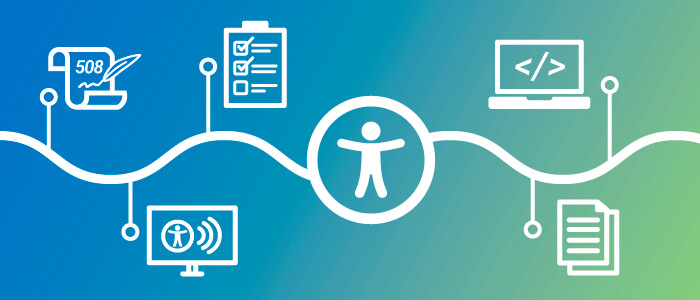In 1990, the signing into law of the Americans with Disabilities Act (ADA) provided a real foundation for accessibility in the U.S. and across the world as a model. Similarly, Section 508 of the Rehabilitation Act and its subsequent refreshes serve as major milestones for accessibility by defining the scope of responsibilities for accessibility in the U.S. Federal Government.
Throughout my career as a person with a disability, I have focused on accessibility, including digital accessibility. During my nearly thirty years of service in the federal government, I served on the advisory council for the Section 508 refresh of 2017. In my previous blog post, I discussed the history of Section 508. In this entry, I’ll break down what Section 508 is, what it enforces, its impact, and what the refresh published in 2017 accomplished.
What is Section 508?
Section 508 refers to a section in the Rehabilitation Act of 1973 that prohibits discrimination on the basis of disability in federal programs or programs receiving federal aid or employment. The Rehabilitation Act has since been updated a few times since its introduction, notably in 1998 to include Section 508–which incorporates the “digital” side of accessibility– and again in 2017.
Section 508 standards apply to the accessibility of “information and communication technology.” This means anything having to do with information and communication technology, from websites to documents, printers, desktop, and mobile software. Section 508 established accessibility to have a broader meaning than just access to a web page, including access to desktop software, mobile apps, documents, and even hardware interfaces like your TV or your printer.
If you’re not a part of the federal government or a federal contractor or subcontractor, then Section 508 most likely doesn’t directly apply to your business. However, keep in mind that many organizations that you do business with may adhere to Section 508 standards, thereby affecting how your products and services compare to others. If you sell to any of the many, many organizations receiving funding from the Federal government, you may indirectly be required to meet Section 508 requirements.
How is Section 508 enforced?
When the federal government develops, procures, maintains, or uses information and communication technology, Section 508 ensures comparable access to people with disabilities as is provided to others. The enforceable part of Section 508 is primarily focused on procurement and implemented within the Federal Acquisition Regulations. Section 508 was implemented in the Federal Acquisition Regulations beginning in 2001. This means that when the government is buying information and communication technology, government entities are required to select the product which best meets accessibility requirements.
For example, say you work in the federal government and you’re buying a bunch of printers. You’ve narrowed down your search to three products that meet your business needs. Section 508 determines that you should look at the accessibility level of each of those three printers and pick the one that’s most accessible. That’s the basic concept of how Section 508 works. In practice, Section 508 gives the people that are making acquisitions a way to compare products fairly.
What’s the impact of Section 508?
Section 508 initiated the federal government’s accessibility transformation and established accessibility as a priority. One of the primary strategies in Section 508 is to affect the purchasing habits of the federal government, which has tens of billions of dollars in IT budget. This set a precedent for private industry by demonstrating that accessibility can have a huge financial impact.
Additionally, Section 508 provided a legal reason for federal agencies to establish accessibility programs. Even though it’s an unfunded mandate, federal agencies now had a responsibility to address accessibility.
What was the Section 508 Refresh in 2017?
The Section 508 electronic and information technology accessibility standards were formally refreshed in 2017 after 11 years of work and deliberation. The refresh required a huge update to the existing federal resources for Section 508 and accomplished two major things. One, it changed the scope of what was included under Section 508 standards to be more inclusive of electronic documents and, two, it improved synchronization of accessibility standards globally.
The refresh standards clarified that things like electronic documents were in scope in the Section 508 standards for federal agencies. Prior to the refresh, it was primarily just websites that fell under Section 508 requirements. However, just because a website is accessible, that doesn’t mean any of the documents it contains are accessible. The Section 508 Refresh in 2017 established that a large majority of both internally-facing and externally-facing electronic documents on federal agency sites also had to be made accessible.
The Section 508 Refresh in 2017 also helped to synchronize the U.S. federal government with worldwide accessibility standards such as the World Wide Web Consortium’s (W3C) Web Content Accessibility Guidelines (WCAG). The guidelines were written to be technology-neutral, however, some effort was required to ensure that applying heavily web-centric guidelines more widely was done carefully. As a result, a lot of discussions took place on how to do that so that we weren’t trying to apply a set of criteria that didn’t match. The outcome was that we did exempt a few WCAG success criteria for electronic documents, and we had to provide some extra guidance around things like mobile apps and software to try to make sure that rules weren’t applied inappropriately.
In total, all the people that worked on the refresh over the 11 years did a remarkable job of creating requirements that are achievable and actually improve accessibility for people with disabilities. The final product, in my opinion, is a good one that should last for quite a while.
Section 508 sets an accessibility standard
Section 508 supports people with disabilities inside and outside the federal government. The effort involved in creating and refreshing Section 508 over the last 20 years resulted in improved methods for practicing accessibility within the federal government, as well as improved experiences of customers with disabilities interacting with the Federal Government.
By enacting Section 508, the Federal Government set a precedent for commercial industry to follow suit– that accessibility can and should be prioritized. Even if your business doesn’t specifically need to follow Section 508, improving the accessibility of your digital properties promotes equal access to all that technology has to offer.
Although the 2017 Refresh is now a few years behind us, its changes are still being implemented. In future refreshes, I’m hopeful that the next round of the standards will make the following accessibility requirements simpler, while also continuing to make changes that make improvements in the lives of people with disabilities.
Where can I learn more?
You can learn more about Section 508 at the U.S. Access-Board at About the ICT Refresh – United States Access Board and also at The General Services Administration Section 508 page.


